Yaliang Li
BOTS: A Unified Framework for Bayesian Online Task Selection in LLM Reinforcement Finetuning
Oct 30, 2025Abstract:Reinforcement finetuning (RFT) is a key technique for aligning Large Language Models (LLMs) with human preferences and enhancing reasoning, yet its effectiveness is highly sensitive to which tasks are explored during training. Uniform task sampling is inefficient, wasting computation on tasks that are either trivial or unsolvable, while existing task selection methods often suffer from high rollout costs, poor adaptivity, or incomplete evidence. We introduce \textbf{BOTS}, a unified framework for \textbf{B}ayesian \textbf{O}nline \textbf{T}ask \textbf{S}election in LLM reinforcement finetuning. Grounded in Bayesian inference, BOTS adaptively maintains posterior estimates of task difficulty as the model evolves. It jointly incorporates \emph{explicit evidence} from direct evaluations of selected tasks and \emph{implicit evidence} inferred from these evaluations for unselected tasks, with Thompson sampling ensuring a principled balance between exploration and exploitation. To make implicit evidence practical, we instantiate it with an ultra-light interpolation-based plug-in that estimates difficulties of unevaluated tasks without extra rollouts, adding negligible overhead. Empirically, across diverse domains and LLM scales, BOTS consistently improves data efficiency and performance over baselines and ablations, providing a practical and extensible solution for dynamic task selection in RFT.
Security Tensors as a Cross-Modal Bridge: Extending Text-Aligned Safety to Vision in LVLM
Jul 28, 2025Abstract:Large visual-language models (LVLMs) integrate aligned large language models (LLMs) with visual modules to process multimodal inputs. However, the safety mechanisms developed for text-based LLMs do not naturally extend to visual modalities, leaving LVLMs vulnerable to harmful image inputs. To address this cross-modal safety gap, we introduce security tensors - trainable input vectors applied during inference through either the textual or visual modality. These tensors transfer textual safety alignment to visual processing without modifying the model's parameters. They are optimized using a curated dataset containing (i) malicious image-text pairs requiring rejection, (ii) contrastive benign pairs with text structurally similar to malicious queries, with the purpose of being contrastive examples to guide visual reliance, and (iii) general benign samples preserving model functionality. Experimental results demonstrate that both textual and visual security tensors significantly enhance LVLMs' ability to reject diverse harmful visual inputs while maintaining near-identical performance on benign tasks. Further internal analysis towards hidden-layer representations reveals that security tensors successfully activate the language module's textual "safety layers" in visual inputs, thereby effectively extending text-based safety to the visual modality.
Respecting Temporal-Causal Consistency: Entity-Event Knowledge Graphs for Retrieval-Augmented Generation
Jun 06, 2025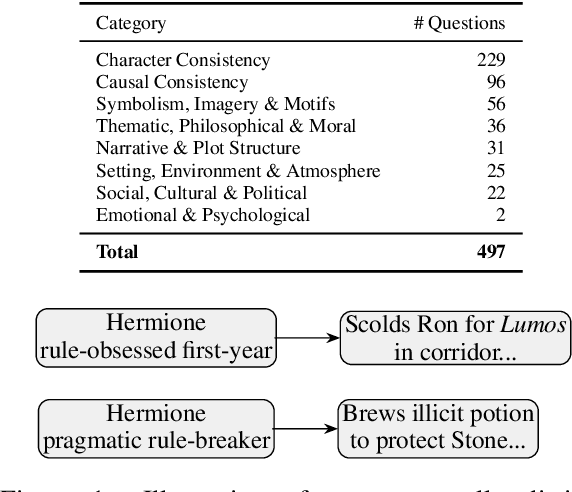
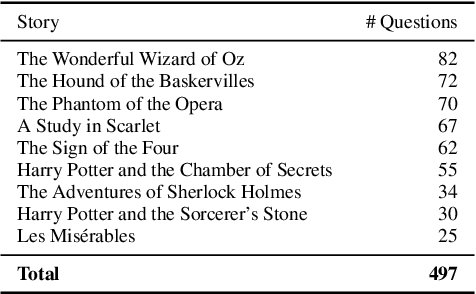
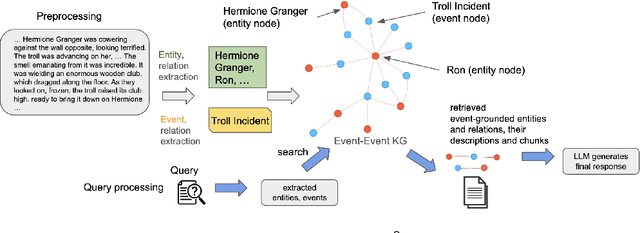
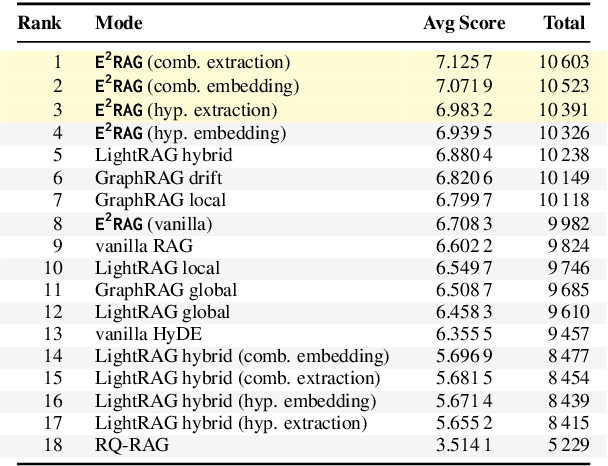
Abstract:Retrieval-augmented generation (RAG) based on large language models often falters on narrative documents with inherent temporal structures. Standard unstructured RAG methods rely solely on embedding-similarity matching and lack any general mechanism to encode or exploit chronological information, while knowledge graph RAG (KG-RAG) frameworks collapse every mention of an entity into a single node, erasing the evolving context that drives many queries. To formalize this challenge and draw the community's attention, we construct ChronoQA, a robust and discriminative QA benchmark that measures temporal, causal, and character consistency understanding in narrative documents (e.g., novels) under the RAG setting. We then introduce Entity-Event RAG (E^2RAG), a dual-graph framework that keeps separate entity and event subgraphs linked by a bipartite mapping, thereby preserving the temporal and causal facets needed for fine-grained reasoning. Across ChronoQA, our approach outperforms state-of-the-art unstructured and KG-based RAG baselines, with notable gains on causal and character consistency queries. E^2RAG therefore offers a practical path to more context-aware retrieval for tasks that require precise answers grounded in chronological information.
Trinity-RFT: A General-Purpose and Unified Framework for Reinforcement Fine-Tuning of Large Language Models
May 23, 2025Abstract:Trinity-RFT is a general-purpose, flexible and scalable framework designed for reinforcement fine-tuning (RFT) of large language models. It is built with a decoupled design, consisting of (1) an RFT-core that unifies and generalizes synchronous/asynchronous, on-policy/off-policy, and online/offline modes of RFT, (2) seamless integration for agent-environment interaction with high efficiency and robustness, and (3) systematic data pipelines optimized for RFT. Trinity-RFT can be easily adapted for diverse application scenarios, and serves as a unified platform for exploring advanced reinforcement learning paradigms. This technical report outlines the vision, features, design and implementations of Trinity-RFT, accompanied by extensive examples demonstrating the utility and user-friendliness of the proposed framework.
DetailMaster: Can Your Text-to-Image Model Handle Long Prompts?
May 22, 2025Abstract:While recent text-to-image (T2I) models show impressive capabilities in synthesizing images from brief descriptions, their performance significantly degrades when confronted with long, detail-intensive prompts required in professional applications. We present DetailMaster, the first comprehensive benchmark specifically designed to evaluate T2I models' systematical abilities to handle extended textual inputs that contain complex compositional requirements. Our benchmark introduces four critical evaluation dimensions: Character Attributes, Structured Character Locations, Multi-Dimensional Scene Attributes, and Explicit Spatial/Interactive Relationships. The benchmark comprises long and detail-rich prompts averaging 284.89 tokens, with high quality validated by expert annotators. Evaluation on 7 general-purpose and 5 long-prompt-optimized T2I models reveals critical performance limitations: state-of-the-art models achieve merely ~50% accuracy in key dimensions like attribute binding and spatial reasoning, while all models showing progressive performance degradation as prompt length increases. Our analysis highlights systemic failures in structural comprehension and detail overload handling, motivating future research into architectures with enhanced compositional reasoning. We open-source the dataset, data curation code, and evaluation tools to advance detail-rich T2I generation and enable broad applications that would otherwise be infeasible due to the lack of a dedicated benchmark.
Comprehensive Evaluation and Analysis for NSFW Concept Erasure in Text-to-Image Diffusion Models
May 21, 2025Abstract:Text-to-image diffusion models have gained widespread application across various domains, demonstrating remarkable creative potential. However, the strong generalization capabilities of diffusion models can inadvertently lead to the generation of not-safe-for-work (NSFW) content, posing significant risks to their safe deployment. While several concept erasure methods have been proposed to mitigate the issue associated with NSFW content, a comprehensive evaluation of their effectiveness across various scenarios remains absent. To bridge this gap, we introduce a full-pipeline toolkit specifically designed for concept erasure and conduct the first systematic study of NSFW concept erasure methods. By examining the interplay between the underlying mechanisms and empirical observations, we provide in-depth insights and practical guidance for the effective application of concept erasure methods in various real-world scenarios, with the aim of advancing the understanding of content safety in diffusion models and establishing a solid foundation for future research and development in this critical area.
Responsible Diffusion Models via Constraining Text Embeddings within Safe Regions
May 21, 2025Abstract:The remarkable ability of diffusion models to generate high-fidelity images has led to their widespread adoption. However, concerns have also arisen regarding their potential to produce Not Safe for Work (NSFW) content and exhibit social biases, hindering their practical use in real-world applications. In response to this challenge, prior work has focused on employing security filters to identify and exclude toxic text, or alternatively, fine-tuning pre-trained diffusion models to erase sensitive concepts. Unfortunately, existing methods struggle to achieve satisfactory performance in the sense that they can have a significant impact on the normal model output while still failing to prevent the generation of harmful content in some cases. In this paper, we propose a novel self-discovery approach to identifying a semantic direction vector in the embedding space to restrict text embedding within a safe region. Our method circumvents the need for correcting individual words within the input text and steers the entire text prompt towards a safe region in the embedding space, thereby enhancing model robustness against all possibly unsafe prompts. In addition, we employ Low-Rank Adaptation (LoRA) for semantic direction vector initialization to reduce the impact on the model performance for other semantics. Furthermore, our method can also be integrated with existing methods to improve their social responsibility. Extensive experiments on benchmark datasets demonstrate that our method can effectively reduce NSFW content and mitigate social bias generated by diffusion models compared to several state-of-the-art baselines.
Enhancing Latent Computation in Transformers with Latent Tokens
May 19, 2025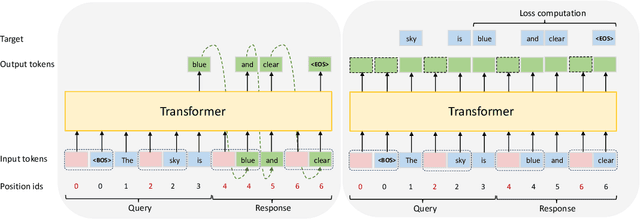

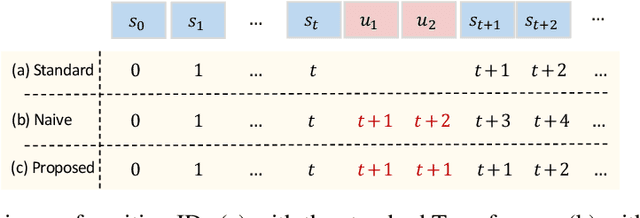
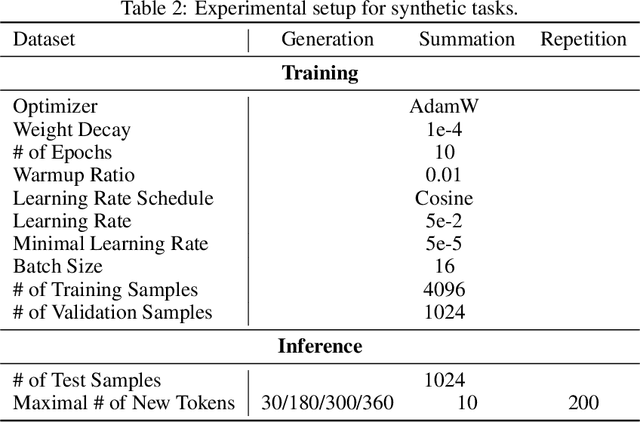
Abstract:Augmenting large language models (LLMs) with auxiliary tokens has emerged as a promising strategy for enhancing model performance. In this work, we introduce a lightweight method termed latent tokens; these are dummy tokens that may be non-interpretable in natural language but steer the autoregressive decoding process of a Transformer-based LLM via the attention mechanism. The proposed latent tokens can be seamlessly integrated with a pre-trained Transformer, trained in a parameter-efficient manner, and applied flexibly at inference time, while adding minimal complexity overhead to the existing infrastructure of standard Transformers. We propose several hypotheses about the underlying mechanisms of latent tokens and design synthetic tasks accordingly to verify them. Numerical results confirm that the proposed method noticeably outperforms the baselines, particularly in the out-of-distribution generalization scenarios, highlighting its potential in improving the adaptability of LLMs.
Tree-based Models for Vertical Federated Learning: A Survey
Apr 03, 2025Abstract:Tree-based models have achieved great success in a wide range of real-world applications due to their effectiveness, robustness, and interpretability, which inspired people to apply them in vertical federated learning (VFL) scenarios in recent years. In this paper, we conduct a comprehensive study to give an overall picture of applying tree-based models in VFL, from the perspective of their communication and computation protocols. We categorize tree-based models in VFL into two types, i.e., feature-gathering models and label-scattering models, and provide a detailed discussion regarding their characteristics, advantages, privacy protection mechanisms, and applications. This study also focuses on the implementation of tree-based models in VFL, summarizing several design principles for better satisfying various requirements from both academic research and industrial deployment. We conduct a series of experiments to provide empirical observations on the differences and advances of different types of tree-based models.
MindGYM: Enhancing Vision-Language Models via Synthetic Self-Challenging Questions
Mar 12, 2025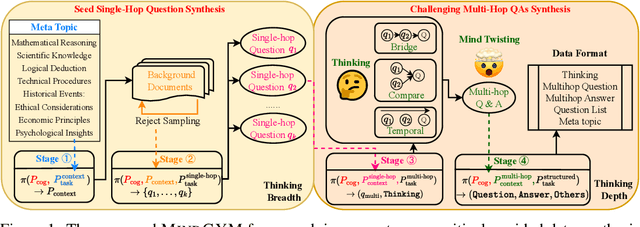
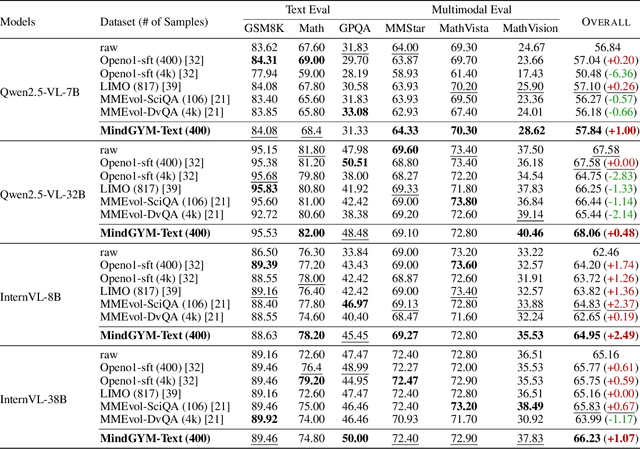

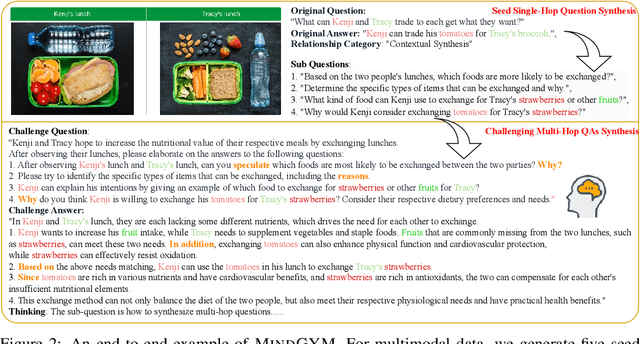
Abstract:Large vision-language models (VLMs) face challenges in achieving robust, transferable reasoning abilities due to reliance on labor-intensive manual instruction datasets or computationally expensive self-supervised methods. To address these issues, we introduce MindGYM, a framework that enhances VLMs through synthetic self-challenging questions, consisting of three stages: (1) Seed Single-Hop Question Synthesis, generating cognitive questions across textual (e.g., logical deduction) and multimodal contexts (e.g., diagram-based queries) spanning eight semantic areas like ethical analysis; (2) Challenging Multi-Hop Question Synthesis, combining seed questions via diverse principles like bridging, visual-textual alignment, to create multi-step problems demanding deeper reasoning; and (3) Thinking-Induced Curriculum Fine-Tuning, a structured pipeline that progressively trains the model from scaffolded reasoning to standalone inference. By leveraging the model's self-synthesis capability, MindGYM achieves high data efficiency (e.g., +16% gains on MathVision-Mini with only 400 samples), computational efficiency (reducing both training and inference costs), and robust generalization across tasks. Extensive evaluations on seven benchmarks demonstrate superior performance over strong baselines, with notable improvements (+15.77% win rates) in reasoning depth and breadth validated via GPT-based scoring. MindGYM underscores the viability of self-challenging for refining VLM capabilities while minimizing human intervention and resource demands. Code and data are released to advance multimodal reasoning research.
 Add to Chrome
Add to Chrome Add to Firefox
Add to Firefox Add to Edge
Add to Edge